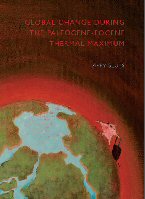
Global change during the Paleocene-Eocene thermal maximum / Appy Sluijs - [S.l.] : [s.n.], 2006 - Doctoral thesis Utrecht University

 |
Global change during the Paleocene-Eocene thermal maximum Global change during the Paleocene-Eocene thermal maximum / Appy Sluijs - [S.l.] : [s.n.], 2006 - Doctoral thesis Utrecht University |
Proxy data indicate that atmospheric CO2 concentrations expected for the next centuries have not been equaled since the early Paleogene, approximately 66 to 45 Million years (Ma) ago. The early Paleogene global climate appears to have been substantially warmer than that of present day, likely in response to high greenhouse gas concentrations. Understanding of the impact of such ‘greenhouse’ conditions on early Paleogene global climate is vital to identify and quantify present and future climate feedbacks related to rising atmospheric carbon concentrations. This thesis is specifically focused on global change that occurred during a brief period of extreme global warming called the Paleocene-Eocene thermal maximum (PETM), approximately 55.5 Million years ago. The PETM, which characterizes the Paleocene-Eocene boundary, associated with this warming is a negative 2.5-6 ‰ stable carbon isotope (δ13C) excursion (CIE), evidencing the fast injection of 12C-enriched carbon in the form of CO2 or CH4 into the global exogenic carbon pool. The apparent conjunction between the carbon input and warming has fuelled the hypothesis that the increased atmospheric CO2 and/or CH4 concentrations caused an enhanced greenhouse effect at the PETM, superimposed on the already high greenhouse gas concentrations of the earliest Paleogene. The duration of the negative δ13C excursion and the subsequent recovery is in the order of 170 thousand years. The carbon injection at the PETM led to extreme ocean acidification, which requires a larger injection of carbon than can be explained by the previously assumed dissociation of submarine methane hydrates. Based on the newly discovered Elmo horizon it is now known that the PETM was not a unique event but the most severe of multiple ‘hyperthermal’ events during the late Paleocene and early Eocene. This strongly suggests an endogenic cause for these phases of rapid global warming. Results from sediment cores from the Arctic Ocean and the New Jersey shelf provide a better constraint on the very high temperatures that prevailed globally during the late Paleocene and early Eocene and particularly during the PETM. These results indicate that climate models cannot realistically produce climates, particularly meridinional temperature gradients, during these episodes of enhanced atmospheric greenhouse gas concentrations. Despite of the globally warm temperatures, Antarctic continental ice was potentially present judging from the significant sea level variations recorded through the latest Paleocene and earliest Eocene. The PETM itself is associated with sea level transgression and a maximum flooding. Finally, based on high-accumulation rate neritic deposits, the onset of the globally recorded acme of the dinoflagellate Apectodinium precedes the onset of the PETM global warming by some 2 kyr, which, in turn leads the CIE by ~3 kyr. Hence, sea surface conditions characteristic of the PETM, including extreme warming, initiated significantly prior to the injection of 12C-enriched carbon. This implies that this injection likely occurred as a result of global change, rather than the other way around, and invokes the dawn of the next challenge: solving the question how global change, including warming, could occur without a change in the isotopic composition of the exogenic carbon pool. keywords: Paleocene-Eocene thermal maximum, Paleocene, Eocene, global warming, greenhouse gases, sea level rise, ocean acidification, paleoclimate, dinoflagellates, temperature gradients |